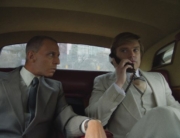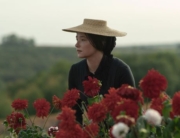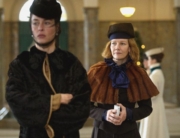The woman of the title is Violeta Parra (1917-1967), an icon of Chilean folk music and art. Her life is told in an elliptical style that emphasizes themes rather than chronology. Parra emerges as a figure of unusual conviction and incandescence as she searches for the musical heritage of her country, earns accolades for her tapestry exhibition at the Louvre, and falls fatally in love with a man half her age. Even in the movie pantheon of artistic iconoclasts, she seems one of a kind. But more than anything else, the biopic is a showcase for actress Francisca Gavilán.
In a fictional television interview that runs throughout the film, we see Parra as she would like to be seen: at once charming and intelligent, candid and utterly singular. In these scenes, Gavilán is both an effortless and precise presence, as much a pleasure to watch as it seems the role was to perform. Violeta dismantles the traps embedded in the interviewer’s questions with a guilelessness so knowing that it is a guile in itself, hinting at the force of will that drives her so furiously through life.
When Parra first encounters the Swiss musician Gilbert Favre (Thomas Durand), the man who will occupy much of her life, Gavilán is a small marvel of glances and gestures, shifting between moods with an ease that throws into startling relief the play between impulsiveness and control. In this scene and elsewhere, director Andrés Wood and cinematographer Miguel Ioan Littin display a deft and subtle hand, crafting images of understated potency. When they frame Violeta and her daughter dancing side by side, bracketed by men’s shoulders within a static frame, the tensions in the room are exposed and exquisitely accentuated. A later image of a falcon hunting a chicken is less notable for its obvious symbolism than for its violence and disquieting beauty.
With a chronology that is loosely implied or jettisoned altogether, the pace drags from time to time. Though the music is both beautiful and beautifully performed, Wood’s propensity to use Parra’s songs as opportunities for montages slips into the didactic. The film tends to portray her art as a direct expression of her emotions; the suggestion that her work might have larger issues on its mind is left largely unexplored. Parra’s success and recognition hover around the fringes of the narrative rather than at its center, allowing her character to take center stage. But at film’s end, she is still something of a mystery, a collection of anecdotes that hint tantalizingly at something greater that is just out of reach.
However, Gavilán is eminently present. She’s a source of pulsing, unadulterated life, both multifaceted and absolutely singular. When she sings, those around her forget to do anything else but listen, and for as long as the song lasts, you will too. When her hands stop strumming, restlessness sets in, but thankfully, the echoes of those songs continue to linger.







Leave A Comment